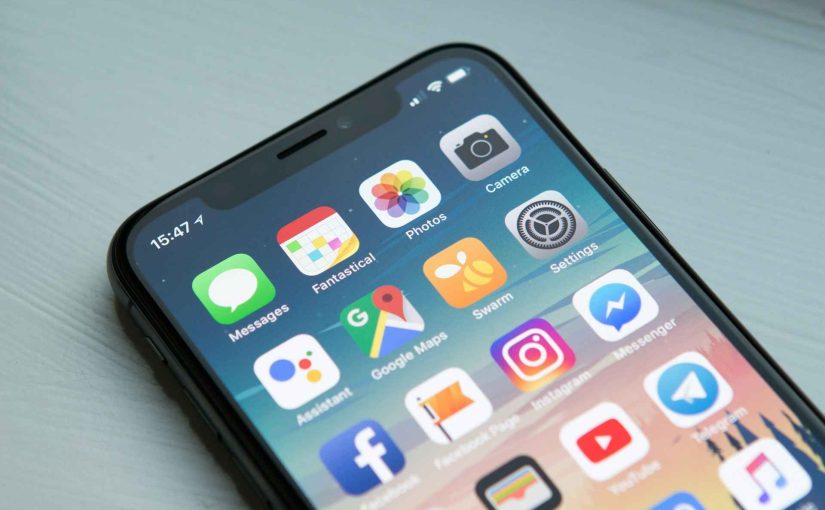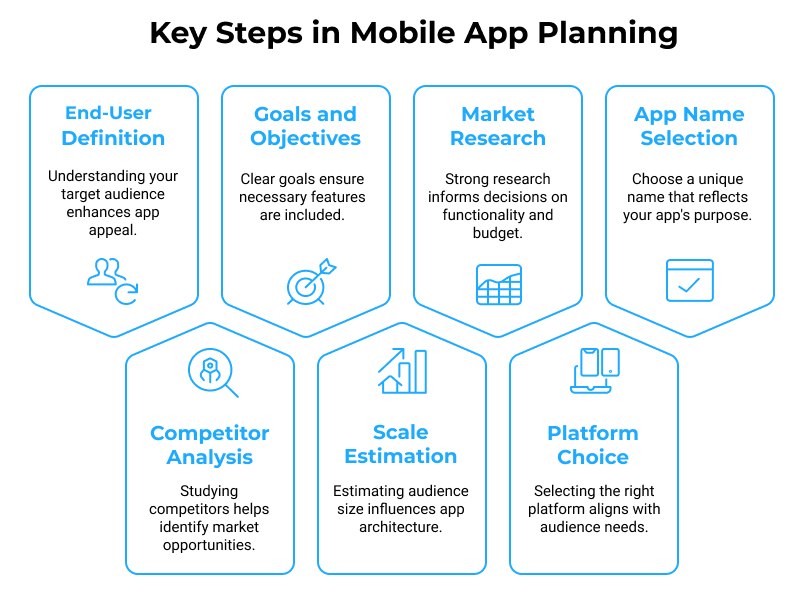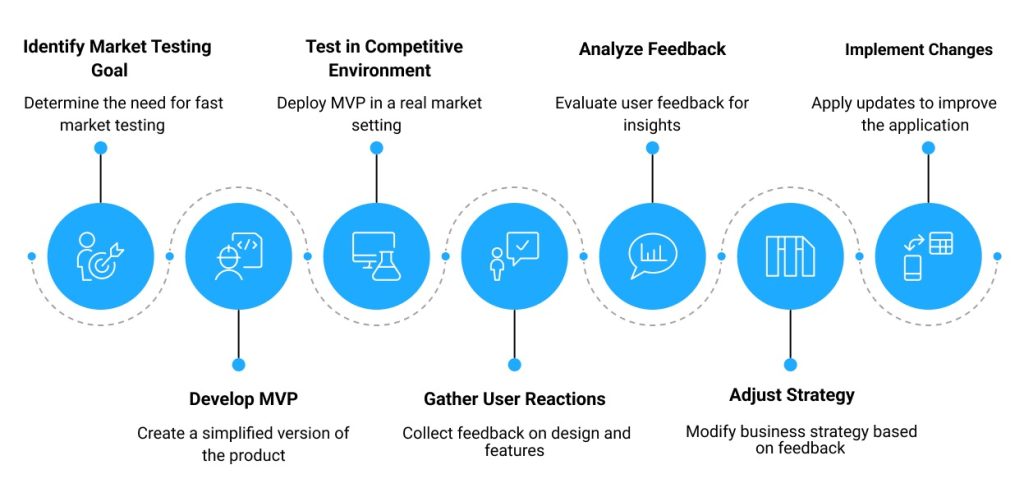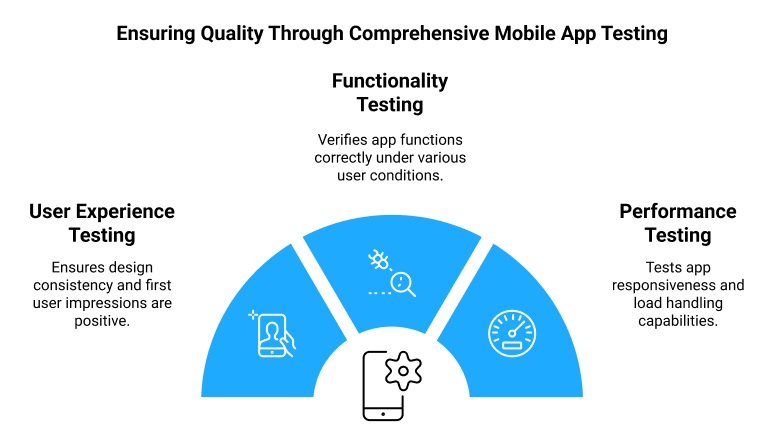
According to global research, the mobile app is valued at approximately USD 330.61 billion in 2025 and is projected to grow to around USD 1103.48 billion by 2034, with a compound annual growth rate (CAGR) of 14.33% over the forecast period. But not all companies know how to use these advantages correctly.
Developex is always happy to help you win the competition in your industry and outpace your rivals. With years of experience helping businesses develop mobile apps that drive growth and user engagement, we understand what it takes to succeed in this space.
In this post, we will discuss everything you need to know about the development process: key steps, how much does mobile app development cost, how long it takes, and what you should consider when embarking on this journey.
Stage 1: Project Definition & Planning
“Your idea is fundamental for a project to start! We work with you to get enough project details, clarify and prioritize your requirements, and prepare a development process roadmap.”
Based on 2025 trends, more and more companies are investing in mobile development and targeting mobile users to increase revenue. However, mobile app development costs can vary significantly. The simplest applications may start at around $10,000–$20,000, while more complex solutions with advanced features, integrations, and custom UI/UX can cost $100,000 or more.
Many factors influence the cost of developing a mobile app: platform choice, app complexity, integrations, design requirements, backend infrastructure, and scalability needs. That’s why it’s crucial to define a clear strategy from the start to ensure the most effective use of your budget.
Here’s what strategic planning includes:
- Defining your end-users: Understanding your target audience in detail will help make the app more attractive and user-friendly for them.
- Analyzing your competitors: Studying competitor apps allows you to identify market standards, spot gaps or weaknesses in their solutions, and find opportunities to offer something better or different.
- Defining the goals and objectives of your application: A clear vision ensures your app includes the necessary features and solves real problems for your users. This is a vital stage—you shouldn’t jump into development without it.
- Estimating the scale of your app and audience size: The expected number of users significantly influences your app’s technical architecture and development cost. Planning for 100 users is very different from planning for 1,000,000. Defining this early helps build a solution that scales efficiently.
- Using market research and data for informed decisions: A strong research foundation helps you define your niche, understand user demand, and make informed choices about functionality, technology stack, scalability, and budgeting.
- Choosing a mobile platform for your app: Your platform decision should align with your target audience and project plans. Typically, development starts with one platform (iOS or Android) and later expands to both for maximum reach.
- App Name Selection: Choose a name that stands out and accurately reflects your app’s purpose. Before finalizing it, confirm that it’s not already in use by searching major platforms like the App Store and Google Play.

Once your goals are defined and the overall plan is clear, the next step is to move from ideas to actionable development steps. This phase involves preparing your product roadmap, structuring, and grouping requirements into implementation phases. Understanding how to develop a mobile app begins with setting a solid foundation – and this is exactly what this stage is about.
If you want to test your idea quickly in real market conditions, consider launching an MVP (Minimum Viable Product) first. This approach helps save time, resources, and costs, while also validating your concept with real users and their feedback.
Stage 2: UI / UX Design
“You’ll see the intended visual appearance of your project materialize as we set up user flows and create wireframes and layouts.”
The main thing about app UI/UX design is the concise look and great user experience while using the app. If there are no troubles with its features – you can consider this stage as successful. At its core, the design should be interactive with a clear and user-friendly interface. Also, your app should have an intuitive workflow to create comfort for customers.
Information architecture and workflows starts with defining the data that will be displayed for the user, and that will be collected from them. Also, you need to prepare any possible path of user navigation through your app. To define all the possible interactions, it is necessary to create comprehensive diagrams of all the workflows.
It is a usual example when designers start their drafts on paper. The digital form of drafts is called a wireframe diagram. These schematics are the low-confidence concept or layout. It is a purely visual structure of your application’s functional requirements.
Creating a Cohesive Design Framework
If you need a fast and economical approach for your design, you need to create wireframes schematics. The most important thing is to consider the specifics of different devices to ensure a high user experience on any platform.
The main role in the productivity of the design process is to guide its conditions. In simple words, it’s a document that defines the design standards for your app. This document specifies the conditions for your company’s branding, icons, fonts, color scheme, etc. This kind of document will increase design productivity and keep the same style of your app during the development process.
On a final visualization phase of your app, mockups are created by applying your design terms guide to the app sketches. To refine your design, there are always changes to its information architecture.
From Mockups to Prototypes
Once the mockup has been created and you can see on the static design how the functionality of the future app will be, it’s time to turn it into a prototype. The main advantage of a prototype is the ability to test the functionality and design of your app at an early stage. In some cases, instead of a prototype, some companies go straight to MVP development to save time and budget.
This allows you to plan for the necessary updates if any needs arise during these input tests. Also, if the functional requirements are not very well thought out, prototyping during the conceptual design phase can be very useful. In some cases, a prototype is used to give it a shot with a test group of users.
Stage 3: Application Development
“Now your app development begins! We use an adaptive approach, with planning and showcasing meetings, giving you greater visibility and control over the scope of the project. “
Your project then proceeds to the mobile application development and programming phase, where planning is the core of the process. Initially, you need to define the technical architecture and choose a technology stack to define the development steps. Most commonly, a regular native or cross-platform mobile app consists of front/back-end and APIs parts.
The front-end of a mobile app is exactly the part that the user will check and see in the process. The back-end part refers to the server-side and database supporting the functionality of your app. And finally, the API part is the method of communication between the application and the database or back-end server.
There can be cases where the application needs to work without the internet, as a result, it will use the local storage for data.
Choosing the Right Technology Stack
Oftenly, for the backend part, you can use almost any programming language. There are two main directions: native development and cross-platform. In the first case, you need to choose the technology stack required for each mobile OS platform. For iOS – Objective-C or Swift is most commonly used as a programming language. For Android, they mostly use Java or Kotlin.
The second way is rapidly growing over the past few years, and cross-platform development of mobile apps is gaining momentum. As the main programming languages, there are three most popular: Flutter, React Native, and Kotlin. There are many pros and cons to each language as well as for native vs cross-platform development. It all depends on your app goals, the audience, and other factors that are determined in the initial stages.
MVP Development and Market Testing

If your goal is to test your market fast, without spending a huge budget, creating an MVP will be the perfect solution for your business. In other words, MVP is a simplified form of your product with a minimal set of features. It is a very successful method of testing your product in a real competitive environment and gathering user reactions to the design and features of the intended application.
In this way, you can create a quality strategy and allocate the right budget for the purpose of your app.
The main focus is to develop specific features to solve basic problems and satisfy early user’s needs. In simple words, it is the minimum necessary assembly of functionality that solves the main problem of the application.
MVP development is essentially an adaptive process. The main principle is that after development you get analytics and make changes in the strategy. It is a proven practice to improve the quality of your application with new updates. In the MVP analytics process, the main advantage will allow you to know what your users want from your app and in the future, you will be able to focus more precisely on solving their problems.
Stage 4: Quality Assurance
“Our detailed and comprehensive QA process includes both functional and exploratory testing processes. When it’s needed, we also use automated testing tools to achieve the highest quality of your application.”
Your goal is a stable app and you want to make it usable and secure? A thorough QA & Testing process must be implemented from the very beginning of the mobile app development process. At the start, Developex team prepares test cases that cover all aspects of testing for a more comprehensive and useful process. The main purpose of such examples is the qualitative fulfillment of test stages, generation of results, quality assessment, and follow-up of corrections for repeat tests.
We believe that involving the QA team in the analysis and testing stages is the best practice. When our QA team fully understands the functional scope, requirements, and goals of your application they will create the most accurate and relevant test cases.
If you want to ensure that you have a quality application, you need to go through at least three mobile apps testing methods, more is much better.
- User Experience Testing. This is the most important stage of testing to ensure that the development plans for the final result are consistent. After all, the workflow, design, and interactivity are making the first impression for your users. At this stage, it is important to make sure that all the points of the design plan are consistent, from fonts, style, color scheme to icon design and navigation. This is a must because it has a direct impact on the intended user experience.
- Functionality Testing. In fact, it is impossible to immediately predict the scenario and behavior of each of your future app users, so the functionality should be tested by as many users as possible to fulfill as many possible conditions as you can. There is always a chance of finding bugs with different users in the same functionality. The main goal of this stage is to make sure that users can use the application without any problems. It can be divided into two sub-stages: unit testing (functional testing of separate functions) and system testing (testing of the application as a whole).
- Performance Testing. Responsiveness is an important part of the user experience. And the first thing worth checking is how fast the application screens load, size, memory leaks, responsiveness to user actions, and many other things that directly affect the user experience. And once your app meets the basic criteria, you need to test how the app handles the load, for example by simulating the maximum number of users. Your app should be able to handle any changes without any problems.

Security Testing Process
The security process plays a key role in the vitality of an app and makes more sense in 2025, amid global user data breaches. More and more applications are susceptible to hacking and theft of user personal data ranging from mailbox access to bank passwords. Thus, security is a direct leverage point for big companies’ reputations when they fail to keep their users safe.
One popular method is to hire a third-party company to perform detailed security testing with an extended scope of checks for your application. If you want to make it inhouse, at least you can consider a few basic security compliance methods, which we’ll discuss further below.
When an application involves a login step from the users, you need to implement a system for monitoring this process, both at the user (phone/laptop) and at the backend side. Also, if the user is not active in the application and does not perform any actions for 10 minutes or more, the session with him should be terminated automatically to ensure a high level of security.
One of the most common login features is storing credentials when the user logs in again. To ensure reliable security, you need to use a responsible and secure data storage service.
If we talk about Apple devices (iOS operating system), the development platform implies a Keychain capability that stores user login data under a specific app.
Also, a not insignificant fact is the testing of all the input forms for user data to eliminate any data leakage from the app and increase security level.
Platform and Device Testing
The final QA point we want to add is platform and device testing. If we look at the trends from 2019 to 2025, the leading mobile device companies make releases at least once a year and in some cases more often. In 2025, the race is getting tougher among hardware, design quality, and firmware, which by the way is updated almost every three months.
Some of the market leaders in mobile devices such as Xiaomi, Samsung, Huawei, LG adapt their products with the Android platform, which is open source.
If we talk about the undisputed giant of the mobile device market Apple, they have a more controlled environment over operating systems and hardware. Nevertheless, there are a huge number of iPhone/iPad devices on the market, and Apple’s technological releases are the most anticipated and discussed.
If for example to test web applications most of the work is done in the Windows ecosystem with browsers like Mozilla and Chrome, then in testing mobile applications everything is much more complicated.
The Importance of Testing in Mobile Application Development
At Developex we determine which OS versions are supported and test your application on mobile phones of different manufacturers, both latest models and more niche ones. Accordingly, to get a high-quality result we test the product during the whole mobile app development process and on different devices and simulators, thus ensuring reliable operation of your application for the end-user.
Some Enterprise-level companies are increasingly adopting the development of their enterprise applications for a single mobile platform, and it is not uncommon to provide devices from the company for their employees to maximize interaction. Of course, there are different cases, but the trend says more frequent development for Apple device platforms and only when necessary for Android devices. This is most likely due to the prevailing popularity of iOS. Although there are cases of simultaneous application development for both platforms.
In our experience, testing is one of the key moments for a successful application in general and should be applied from the early stages, the more detailed – the better. That’s why we advise you to focus on the testing strategy if you want to get a quality product in the end.
Between testers, there are different methods of delivering the build of your application. For example, when working on Apple device applications, the most common approach is to use Testflight. And if we talk about testing Android apps, over-the-air or OTA is used.
Stage 5: App Release And Ongoing Support
“Finally, your solution is ready. Next, you need to deploy it and deal with the daunting process of submitting your application in store. Developex expertise based on providing support, maintenance, and upgrades for iOS and Android mobile apps using the latest technology.”
App Submission Process and Performance Tracking
If you plan to release an app for iOS, you need to submit the app to the App Store, for Android to Google Play. But in both cases, you will need a developer account in the required store. First, you need to prepare metadata for the store: title, description, category, keywords, launch icon, screenshots.
If you publish on the App Store, the iOS app will take up to two weeks for acceptance by the App store, depending on its quality and how well it meets Apple recommendations. During the release process, if a user login is required, a test account must be provided to Apple.
There’s no need for any validation for Android apps. Once you publish your app, it needs less than one day to become available.
There are many mobile analytics platforms with which you can track performance metrics to measure success. An important point is to check reports of crashes and other problems from users, so you can fix bugs for the future. It’s not uncommon for there to be a system of rewards for users for submitting a report which forms the basis of future improvements and updates.
As for the updates, the procedure for submission and review is the same as for the applications. In both ways with native and cross-platform, an important thing is necessary to constantly monitor the development of technology and update the application to new devices and OS platforms.
Summary
On the finish line, we at Developex believe that app development continues even after release with updating new features and secure process support.
We are a leading Mobile app development company and among our customers, there are industry leaders such as Corsair, Logitech, AMD, Intel and you can easily join this list of success.
For the last 20 years, we have been providing mobile application development services in different industries with high caliber results for our customers. We follow agile processes and always keep up with the latest techniques and technology to ensure your application runs perfectly.
So you’ve read our recipe and we are sure you gain questions. It’s easy to get answers by emailing us and even schedule an intro call with our expert to discuss how to turn your idea into a profitable app.






